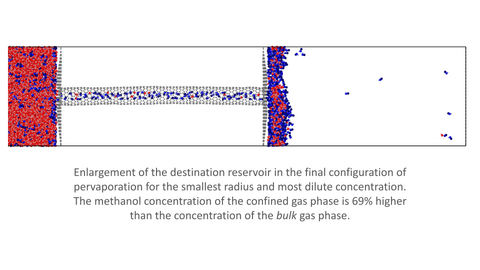Building: Cero Infinito
Room: Posters hall
Date: 2024-12-12 02:00 PM – 04:00 PM
Last modified: 2024-11-19
Abstract
This study investigates the pervaporation process of water-methanol mixtures through graphene nanotubes using molecular dynamics simulations. The system consists of two reservoirs connected by a graphene nanotube, where heating induces the flow of the mixture. We explored how the confinement in nanotubes of different radii affects the separation efficiency during pervaporation.
Simulations were performed under the NVT ensemble at 398 K. We used the TIP4P- 2005 potential for water and the OPLS-2016 potential for methanol, with the REBO potential for the initial relaxation of the graphene structure. The results show that in nanotubes with smaller radii, a single-file regime takes place. This confinement enhances the separation, as methanol and water molecules must move in a highly organized manner through the narrow space,improving selectivity.
For a methanol molar fraction of 0.115, the vapor phase concentration of methanol increased by up to 69 % after passing through the nanotube at 398 K, showing high efficiency in separation. In contrast, larger radii allow for a more layered distribution of the molecules, which results in less efficient separation compared to the smaller radii. This highlights the critical role of confinement in controlling the separation process.
These findings suggest that smaller radius graphene nanotubes, which induce a single-file transport regime, offer superior selectivity for water-methanol separation during pervaporation. The ability to fine-tune the nanotube's radius and the operating conditions presents a promising pathway for optimizing separation technologies in industrial applications.
